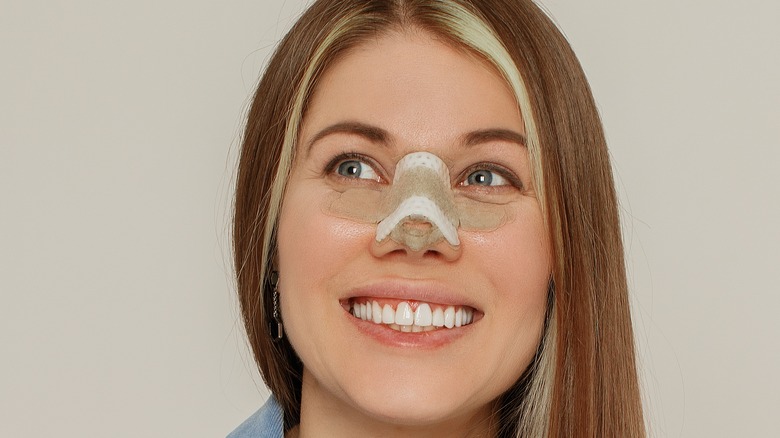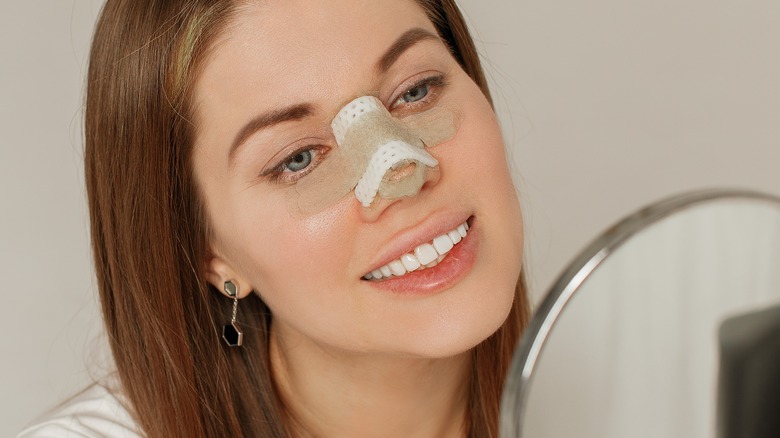What You Need To Know About Healing From A Nose Job
People get a nose job, or rhinoplasty, for both cosmetic and medical reasons. People might get a nose job to improve their breathing problems, or they want to enhance the appearance of their nose. According to TLKM Plastic Surgery, a rhinoplasty can narrow the nose bridge, alter the shape of the tip, flatten bumps or fill nose indentations, and modify nostrils.
The nose is one of the most outstanding features on the face. A nose job can make dramatic changes to the way you look for the better, which explains why it's such a popular cosmetic surgery operation in the U.S. Per a 2017 study conducted by the American Society of Plastic Surgeons, 218,000 nose reshaping procedures were performed that year. Generally speaking, nose jobs are safe and post-op complications are rare (via Mayo Clinic). If you're planning on having a nose job, here's everything you should know about the healing process so you can prepare yourself before coming under the knife.
How long it takes to heal from a nose job
A nose job is an outpatient procedure, meaning patients can go home after the operation, Dr. Robert Kotler points out. In order to protect and support the new nose shape, most rhinoplasty patients will have their surgery site stitched up on the inside and their nose bandaged on the outside, where a splint will be applied. Usually, this dressing needs to be left on for a week. For at least 24 hours following the procedure, you must keep your head elevated and sleep with the support of two to three pillows to help drain blood from the nose.
There will be bruising and swelling, but they will dissipate over time. Per The Face Experts, 90% of the swelling is typically gone in around four to eight weeks, but it may take up to a year for the swelling at the tip to entirely subside. That said, you'll start seeing noticeable improvements in your nose and be ready to flaunt it two weeks post-op.
Healing from an open rhinoplasty vs. a closed rhinoplasty
The degree of swelling depends on the type of nose job you have. For instance, there's a difference in the healing process and recovery speed between an open rhinoplasty and a closed rhinoplasty, which has largely to do with the expanse of surgical incisions. Per Raadina Health, an open rhinoplasty involves the surgeon cutting the sides of the nasal fins, the area of the nose bridge that divides the primitive nasal cavity from the primitive oral cavity, as well as the inside of the nostrils. Meanwhile, in a closed rhinoplasty, the surgeon typically performs only two incisions inside the nostrils.
Because of these differences, an open rhinoplasty has a longer surgery time. In terms of recovery, an open rhinoplasty involves more swelling, more visible scars, and a longer recovery period. Meanwhile, a closed rhinoplasty boasts a faster healing period and fewer visible scars. However, a closed rhinoplasty limits visibility and is not fit for those seeking extensive improvements through a revision rhinoplasty. On the other hand, an open rhinoplasty gives the surgeon more access to underlying bone and cartilage structure, allowing for more accuracy when correcting nasal deformities or deviations, plastic surgeon Cameron Craven shares on Westlake Dermatology. Because of its visibility, an open rhinoplasty is a great choice for revision rhinoplasty or for challenging cases of any sort.
Wearing a splint
The most humbling part of a post-rhinoplastic recovery process is probably having to wear a nose splint for anywhere from a week to three weeks. Not only does it feel redundant on your face, it tells everyone around you that you just had a nose job. However, having a nose splint in place is an essential part of post-operative care, without which your hard-earned nose would be more vulnerable to injuries and damage before it's completely healed. Nose splints are small devices made of metal, plastic, or silicone that serve to protect the nose bridge and support the nasal septum, keeping the recently repositioned bones secure during the healing process, per aesthetic plastic surgeon William Franckle, M.D., FACS.
According to Dr. Jack Zoumaras from Artiste Plastic Surgery, your contoured cartilage, sculpted bones, and severed soft tissues become more fragile after a rhinoplasty. This necessitates the presence of splints to hold them together in the new position, reduce the risk of misplacement, and minimize swelling. Besides, having a splint taped to your nose also reminds you to be extra careful with your face, lest you break your new nose. Typically, there are two types of nose splints: internal and external. Internal nose splints are attached to the inside of your nostrils with several stitches, whereas external splints are placed outside your nose through medical tape or a medical-grade adhesive tape.
Diet and exercise while recovering
After a nose job, you should refrain from strenuous activities for three to six weeks, WebMD warns. These include running, jogging, bending, or any form of physical exertion that might put your newly altered nose at risk of an accident or exacerbate your swelling. When you exercise vigorously, you get your blood pumping and flowing, which increases the swelling and impairs your rhinoplasty results. When it comes to sexual activity, Dr. Robert Kotler advises keeping it to a minimum for at least 10 days to avoid nose accidents. Nose piercings are also a no go for at least three months after the surgery, per Toronto Rhinoplasty Surgery.
Even when your nose is public-ready, avoid going into the sun because the glaring UV rays can cause discoloration on your surgical site and result in complications. During the first 24 hours post-op, Dr. Travis T. Tollefson recommends consuming bland, non-greasy foods with a healthy balance of protein and carbohydrates to reduce swelling. Keeping yourself hydrated with sufficient water to flush toxins out from your system also helps reduce inflammation more quickly. Refrain from sodium intake, which can lead to fluid retention. Most importantly, prioritize resting and relaxing your mind as your swelling should have subsided after the first week.
Avoiding getting your nose wet
During your rhinoplasty recovery, water is your worst enemy. You need to make sure the splint applied to your nose stays dry at all times until it's safely removed. This means that you can shower or have a bath two days after surgery as long as you protect your splint with plastic wrap, advises plastic surgeon Dr. Joshua D. Rosenberg from Mount Sinai. If you need a hair wash, have someone wash your hair for you as you lean your head against the sink.
When it comes to facial hygiene, glide a cotton pad or a reusable cloth soaked with gentle micellar water around your bandages to get rid of impurities. Dermatologist Dr. Whitney Bowe tells Allure, "You do not want to get your bandages wet or splash the skin post-surgery, so it's safer to just use micellar water as a single step post-op." Swimming is also off the table shortly after having your nose reshaped. To protect your surgical sites and nasal passages from the irritating effect of chlorine and physical pressure, refrain from swimming for at least six weeks or until your surgeon gives you permission to do so, per Elite Plastic Surgery.
Every post-operative process comes with do's and dont's, so don't get all worked up. As you recover from a rhinoplasty, give your nose some time to heal and heed your surgeon's instructions to a tee to achieve optimal results.





